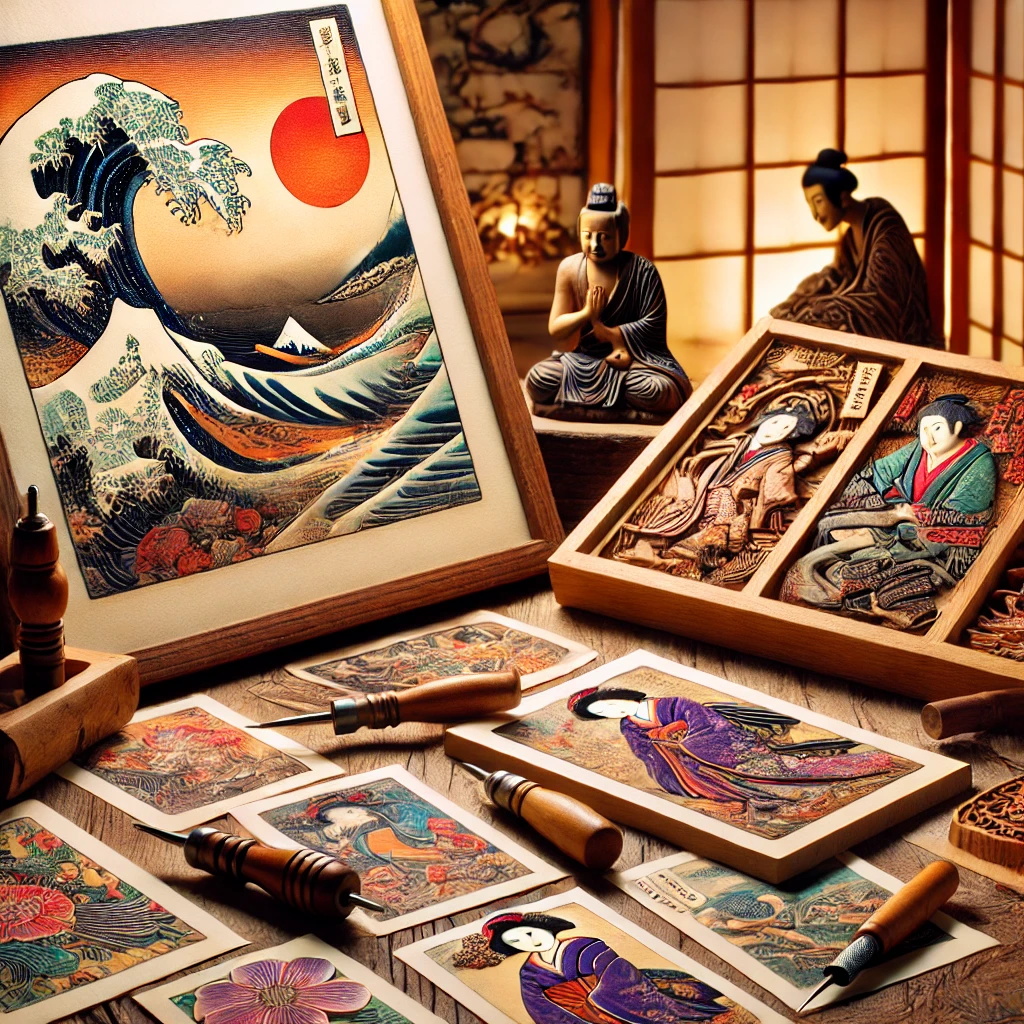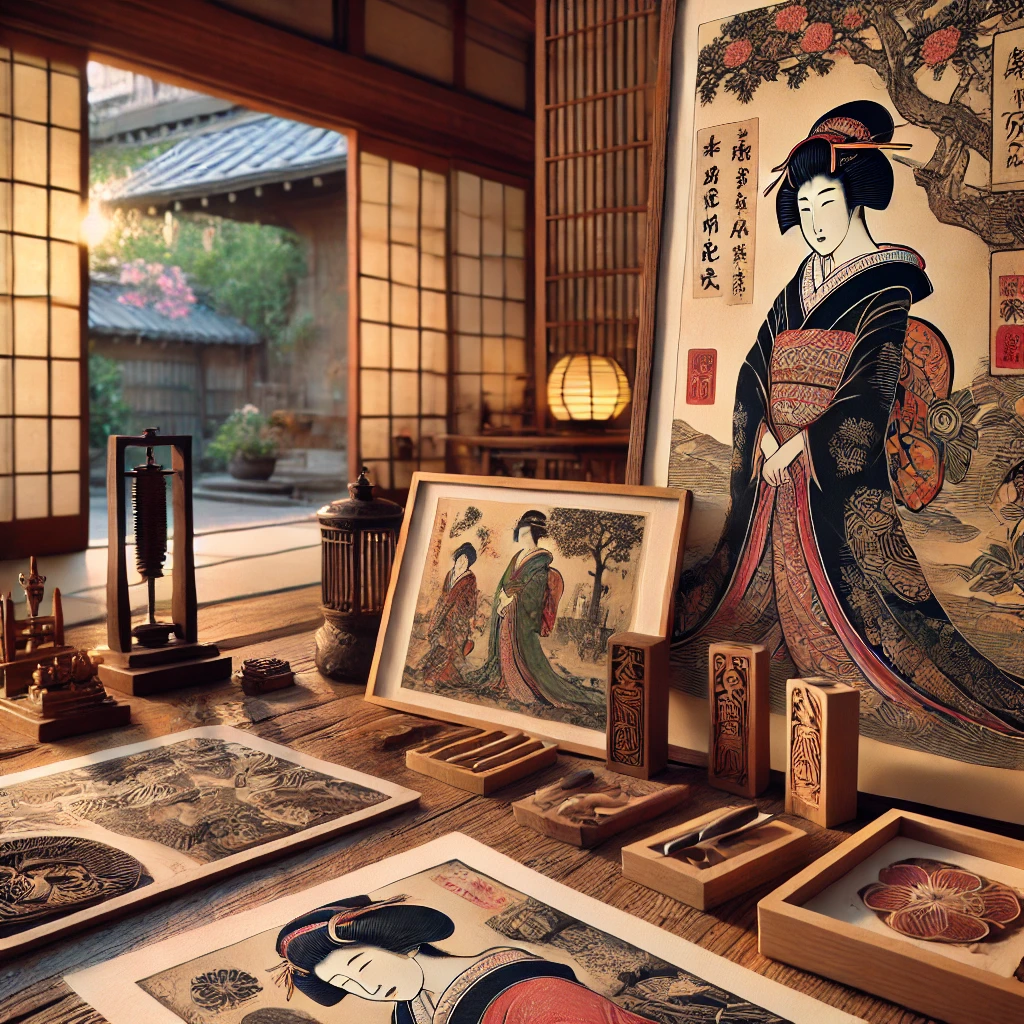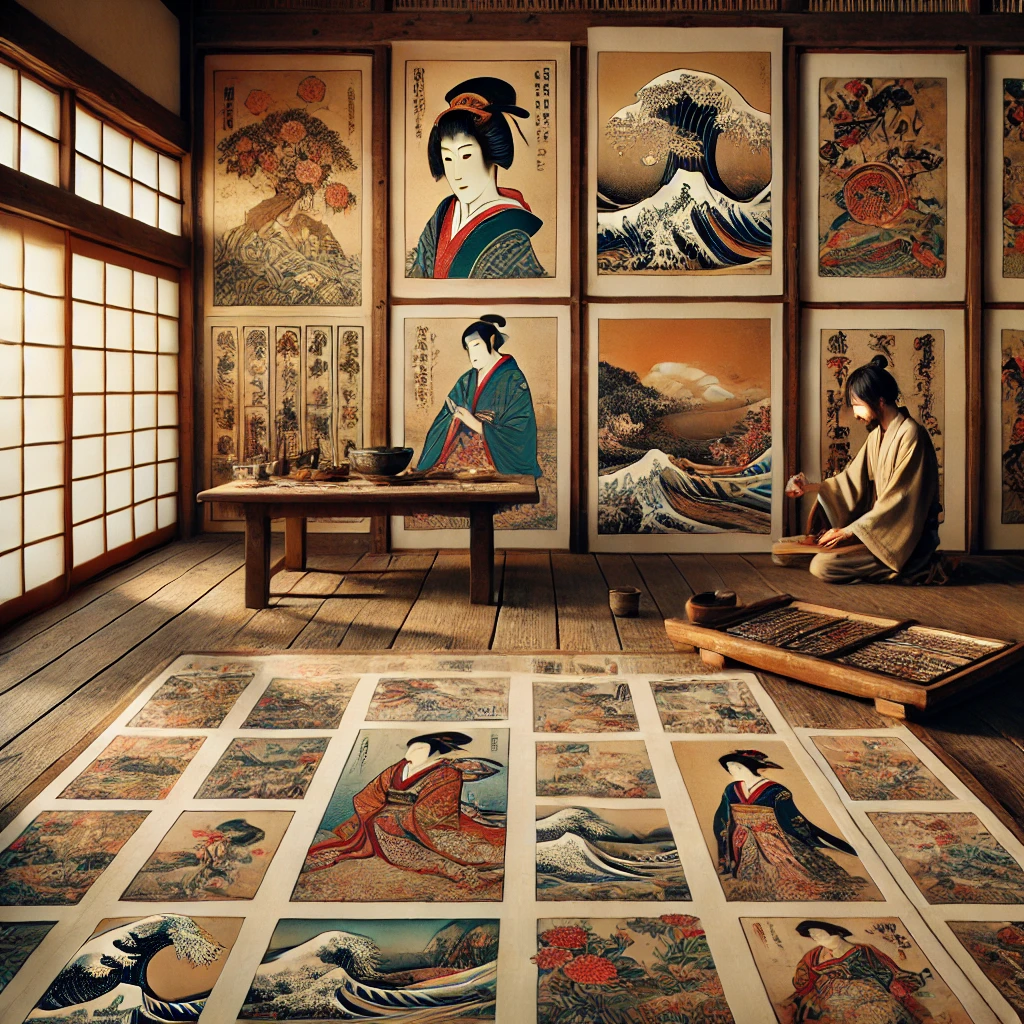Table of Contents

Introduction to Ukiyo-e
Ukiyo-e, which translates to ‘pictures of the floating world,’ is a distinguished genre of Japanese art that emerged during the Edo period, spanning from 1603 to 1868. This captivating art form found its roots in the vibrant cultural and social milieu of Japan‘s urban settings during this era. Initially, Ukiyo-e focused on the ephemeral pleasures of life, depicting beautiful women, kabuki actors, landscapes, and scenes of everyday life. It offered a glimpse into the pleasures and transience of the world, embodying a philosophy that celebrated beauty in the ephemeral.
The term “Ukiyo” itself reflects a worldview that emerged from the realities of urbanization and the rise of the merchant class, which led to an increased interest in leisure and the arts. With advancements in woodblock printing techniques, artists could produce multiple copies of a single image, democratizing access to artwork. This accessibility contributed to the art form’s popularity, allowing it to flourish in a culture increasingly fascinated by the visual representation of both beauty and the ordinary.
Ukiyo-e is characterized by its vibrant colors, intricate patterns, and fluid lines, which create a distinctive aesthetic appeal. Thematically, these prints encompass various subjects, notably landscapes—like the iconic works of Katsushika Hokusai—and the portrayal of women known for their grace and elegance. Such themes not only celebrate beauty but also embody deeper cultural narratives, reflecting societal values and the aesthetics of the time. As we delve into the history and significance of Ukiyo-e, it becomes clear that these prints are more than mere images; they represent a profound connection to the cultural identity of Japan during a transformative period.
Historical Context: The Edo Period
The Edo period, which lasted from 1603 to 1868, marked a significant era in Japanese history characterized by the establishment of the Tokugawa shogunate. This period brought unprecedented stability to Japan after centuries of feudal warfare, enabling a flourishing of culture and commerce. The isolationist policies of the shogunate limited foreign influence, thereby fostering a unique Japanese culture that profoundly influenced the arts, including Ukiyo-e woodblock prints.
One of the notable socio-political conditions of the Edo period was the rise of urban centers. As populations swelled in cities like Edo (modern-day Tokyo), Kyoto, and Osaka, a vibrant merchant class emerged. This urbanization facilitated the growth of a consumer culture that craved entertainment and art, which Ukiyo-e effectively fulfilled. The art form depicted scenes of daily life, landscapes, and beautiful women, catering to the tastes of the new urban populace while simultaneously rendering the art accessible to a wider audience.
Economically, the Edo period saw an expansion of trade and commerce. The newly affluent merchant class sought to express their wealth and sophistication through the acquisition of art, including woodblock prints. As such, Ukiyo-e evolved as a distinct genre that appealed to both aristocrats and commoners alike, reflecting the changing dynamics of social class during this time. The financial prosperity and the cultural thirst of urban residents led to an artistic renaissance, marking Ukiyo-e as a significant component of Japanese heritage.
Overall, the Edo period was crucial in shaping Ukiyo-e, as the interplay of stable governance, urbanization, and economic growth created a fertile ground for this remarkable art form to flourish. The legacy of Ukiyo-e, deep-rooted in the conditions of its time, continues to resonate in the world of art today.
Techniques of Ukiyo-e Printing
Ukiyo-e, a traditional form of Japanese woodblock printing, showcases the remarkable craftsmanship and collaborative efforts of various artists and artisans. The process begins with the production of the woodblocks, where the initial design is drawn onto paper. This drawing, executed by the designer, is then transferred to a block of wood—typically cherry wood, known for its fine grain—which serves as the printing surface.
Once the design is marked onto the wood, the carver meticulously chisels away the areas not intended for ink. This step is crucial, as the depth and precision of the carving will directly affect the final print quality. The carving requires considerable skill and patience, as the artisan must maintain the integrity of the artist’s design while ensuring that the block is durable for multiple prints.
After the carving process, the next step involves preparing the colors. Traditional Ukiyo-e prints often use a limited palette, with natural pigments derived from minerals and plants. The printer then applies these pigments to the carved woodblock, ensuring even coverage. Each color typically requires the use of a separate block, necessitating precise alignment—known as registration—when the prints are layered.
The printing process itself is completed using a hand-held tool known as a baren, which allows the printer to apply even pressure across the entire surface of the block. This technique results in the rich, vibrant colors characteristic of Ukiyo-e. The collaborative nature of Ukiyo-e is highlighted here, as each member of the team plays a vital role; from the designer conceptualizing the image to the carver translating it into wood, and finally, the printer who brings the artwork to life, with publishers managing the distribution and sale.
Significant Artists and Masterpieces
Ukiyo-e, often translated as “pictures of the floating world,” experienced significant growth and evolution in Japan from the 17th through the 19th centuries, largely attributed to influential artists whose works became synonymous with the movement. Among these, Katsushika Hokusai stands out as one of the most celebrated figures. His iconic piece, “The Great Wave off Kanagawa,” part of the series “Thirty-Six Views of Mount Fuji,” exemplifies his innovative use of perspective and bold colors, which significantly impacted both Japanese art and Western artists of the Impressionist movement. Hokusai’s extensive body of work not only included landscapes but also portraits of beautiful women and scenes from folklore, reinforcing the diverse nature of Ukiyo-e art.
Another titan in the Ukiyo-e domain is Utagawa Hiroshige, known for his poignant landscapes and depictions of nature. His series “The Fifty-Three Stations of the Tōkaidō” showcases his masterful ability to capture transient moments in a serene and evocative manner. Hiroshige’s use of atmospheric perspective and time of day imbued each print with a unique emotional quality, further solidifying his central role in the movement. His influence reached far beyond Japan, inspiring various artists and movements worldwide, emphasizing the global appreciation of Ukiyo-e.
Finally, Kitagawa Utamaro deserves mention for his exquisite images of bijin, or beautiful women. Utamaro’s works, such as “Ten Types of Female Physiognomy,” reflect not only his technical mastery but also an intimate exploration of feminine beauty and character. His detailed portrayals and innovative use of shading set a standard for portraiture in Ukiyo-e and helped elevate the genre to unprecedented artistic heights. The legacies of these significant artists are vital to understanding the evolution of Ukiyo-e, as each artist contributed uniquely, shaping the visual and cultural landscape of Japan during their respective periods.
Themes and Subjects in Ukiyo-e
Ukiyo-e, a genre of Japanese woodblock printing, encompasses a rich variety of themes and subjects that reflect the cultural, social, and political milieu of their time. One prominent theme is the portrayal of landscapes, where artists such as Hokusai and Hiroshige depicted serene natural scenes with meticulous attention to detail. These landscape prints not only capture the beauty of Japan’s varied topography but also promote a collective appreciation for nature, aligning with Shinto beliefs that emphasize the spiritual significance of the natural world.
Another vital subject in Ukiyo-e is the depiction of kabuki actors. These prints serve to immortalize the personalities and performances of renowned actors, showcasing their elaborate costumes and expressive poses. The kabuki theater was immensely popular in Edo-period Japan, and these images contributed to the cultural phenomenon by allowing fans to cherish their favorite performers even outside the theater. The artistry involved in these prints demonstrates a deep appreciation for the theatrical arts, bridging visual and performance art.
Beautiful women, or “bijin,” constitute another significant theme in Ukiyo-e. These prints often highlight the grace and elegance of women, presenting them in various settings, from leisurely activities to traditional tea ceremonies. They reflect societal ideals of beauty and femininity, while also implicitly addressing themes of gender roles within the Edo society. Furthermore, the representation of women in Ukiyo-e often showcases their involvement in cultural practices, thus revealing the multifaceted roles they played during this period.
Lastly, historical events and scenes from everyday life are prominently featured, depicting significant moments in Japan’s history and societal norms. These works often serve as visual narratives, providing insight into the events that shaped Japan, from significant battles to festivals. By examining these themes in Ukiyo-e, one can gain a deeper understanding of the values and interests prevalent during its creation, enhancing appreciation for this artistic tradition beyond surface aesthetics.
The Influence of Ukiyo-e on Western Art
The artistic movement of Ukiyo-e, which flourished in Japan from the 17th to the 19th centuries, has left an indelible mark on Western art. Its woodblock prints, characterized by their vibrant colors and intricate details, captivated a range of Western artists, particularly during the late 19th century. The introduction of Ukiyo-e to Europe coincided with the emergence of Impressionism, a pivotal period where artists sought to explore new techniques and themes. Prominent figures, such as Vincent van Gogh, were profoundly inspired by the composition and stylistic elements inherent in Ukiyo-e prints.
Van Gogh’s admiration for Japanese art was evident in his late works, where he adopted aspects of Ukiyo-e, such as bold outlines, flattened perspectives, and an unconventional approach to color. The prints imbued his paintings with a sense of vibrancy and dynamism, challenging the prevailing norms of Western artistic conventions. This integration fostered a unique blend of Eastern aesthetics with Western techniques, enriching both traditions.

Furthermore, the broader Art Nouveau movement also drew upon Ukiyo-e prints, blending natural forms and organic shapes into their design principles. Artists like Alphonse Mucha infused their works with the flowing lines and decorative motifs that were emblematic of Ukiyo-e style. This cultural exchange stimulated a dialogue between East and West, leading to innovations in graphic design and decorative arts, as Western artists began to embrace these new perspectives.
In addition to influencing individual artists, Ukiyo-e prints played a pivotal role in shaping Western perceptions of Japanese culture and aesthetics. This engagement not only facilitated artistic cross-pollination but also laid the groundwork for future movements, heralding a new era of inclusiveness and diversity in the art world. The enduring legacy of Ukiyo-e thus continues to resonate, illustrating the profound interconnectedness of global artistic expressions.
Modern Interpretations and the Revival of Ukiyo-e
Ukiyo-e, the traditional Japanese woodblock print art, has experienced a significant revival in contemporary art circles. Artists today are not merely replicating the historical techniques but are reinterpreting these methods to communicate modern themes and messages. This renaissance can be attributed to a variety of influences, including globalization and the rise of digital media. Artists blend traditional Ukiyo-e aesthetics with contemporary practices, allowing for an exciting fusion that resonates with new audiences.
Many modern artists adopt Ukiyo-e techniques, such as woodblock printing, but infuse these with current issues like environmentalism, urbanization, and identity. This synthesis of old and new not only preserves the essence of Ukiyo-e but also expands its relevance in today’s artistic landscape. By drawing on the vibrant colors and dynamic forms characteristic of this style, contemporary creators breathe new life into a centuries-old tradition, demonstrating that Ukiyo-e can evolve without losing its foundational principles.
Exhibitions and museums play a pivotal role in this revival, hosting shows that feature both traditional and modern Ukiyo-e works. These venues serve as important platforms for educating the public about the historical significance of woodblock prints while highlighting contemporary reinterpretations. Galleries are increasingly showcasing pieces that blend classical Ukiyo-e techniques with modern artistic expression, emphasizing the enduring appeal of this medium. Furthermore, the popularity of online exhibitions has expanded accessibility, allowing global audiences to engage with both historical and modern interpretations of Ukiyo-e.
In summation, the modern interpretations and revival of Ukiyo-e represent a dynamic dialogue between the past and present. This fusion continues to inspire a new generation of artists, ensuring that this traditional art form not only persists but thrives in the contemporary art scene. Through the efforts of artists and institutions, Ukiyo-e remains a vibrant part of Japan’s cultural heritage while adapting to the evolving artistic landscape.
Collecting and Preserving Ukiyo-e
Ukiyo-e woodblock prints hold significant cultural and artistic value, capturing the essence of Japanese art from the Edo period to the present day. Their popularity has led to a vibrant market, making the act of collecting these prints both a passion and an investment. Collectors play a pivotal role in the preservation of Ukiyo-e, as their enthusiasm can drive the interest and funding necessary for conservation efforts. Institutions such as museums and galleries also contribute to the safeguarding of these pieces, ensuring they are accessible to the public while also protecting them from degradation.
The art market for Ukiyo-e prints has seen fluctuations, with certain pieces garnering substantial prices at auction due to their rarity, condition, and historical significance. This demand has prompted a growing number of collectors, both private and institutional, to seek out these works. Understanding the nuances of collection—such as authentication, provenance, and condition—is essential for anyone looking to invest in Ukiyo-e prints. Involvement in this market not only fosters appreciation for these artworks but also underscores the necessity for responsible stewardship.
Conservation efforts for Ukiyo-e are crucial, given that these prints are often made from organic materials that can deteriorate over time. Proper storage conditions, including climate control and protective wrapping, can significantly extend the lifespan of these historical artifacts. Specialists in conservation work diligently to restore damaged prints using techniques that respect the original materials and methods. Furthermore, transferring knowledge through workshops and publications helps raise awareness about best practices for care among collectors and enthusiasts alike.
Best practices for preserving Ukiyo-e prints include avoiding direct sunlight exposure, using archival-quality materials for storage, and consulting with conservators for any restoration needs. By prioritizing these steps, collectors can ensure that these splendid woodblock prints are not only appreciated in the present but also safeguarded for future generations to admire.
Conclusion: The Lasting Legacy of Ukiyo-e
Ukiyo-e woodblock prints have carved a significant niche in the history of art, reflecting both the cultural evolution of Japan and the artistic innovation of different eras. Originating during the Edo period, this art form captured the transient beauty of everyday life, landscapes, and notable figures, which resonates strongly with audiences even today. The term ‘Ukiyo-e’ translates to ‘pictures of the floating world,’ signifying the ephemeral nature of existence that these prints so vividly depict. This unique perspective has fostered an appreciation for the everyday and the ordinary, elements that remain timeless in their appeal.
The historical importance of Ukiyo-e is immense, providing insights into not only the aesthetics of the time but also societal norms, fashion, and the shifting dynamics of Japanese life. These prints served as a critical medium for communication and cultural exchange, influencing Western artists such as Vincent van Gogh and Claude Monet, who were captivated by their vibrant colors and compositions. The enduring legacy of Ukiyo-e is evident in contemporary art, where both traditional techniques and thematic elements continue to inspire new generations of artists around the world.

Moreover, the cultural significance of Ukiyo-e extends beyond mere artistic value. They act as a bridge connecting Japan’s multifaceted past with its vibrant present, highlighting themes of nature, beauty, and the human experience. Today, the popularity of Ukiyo-e motifs is witnessed in various forms, from fashion to design, showing that this art form, while historical, remains relevant and influential. Thus, the essence of Ukiyo-e continues to echo through time, making it a valuable attribute not only of Japan’s cultural heritage but also of the global artistic landscape.





